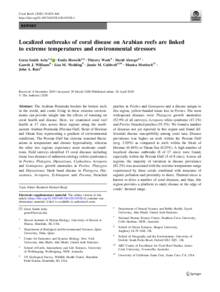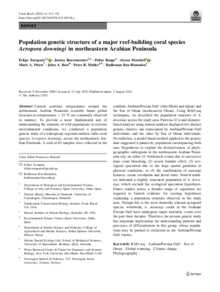Document
Localized outbreaks of coral disease on Arabian reefs are linked to extreme temperatures and environmental stressors.
Identifier
DOI: 10.1007/s00338-020-01928-4
Source
Coral Reefs. v. 39, 3, p. 829-846
Contributors
Howells, Emily., Author
Work, Thierry., Author
Abrego, David., Author
Williams, Gareth J. , Author
Wedding, Lisa M., Author
Caldwell, Jamie M. , Author
Moritsch, Monica., Author
Burt, John A. , Author
Country
Germany.
City
Berlin
Publisher
Springer.
Gregorian
2020-06-01
Language
English
English abstract
The Arabian Peninsula borders the hottest reefs in the world, and corals living in these extreme environments can provide insight into the effects of warming on coral health and disease. Here, we examined coral reef health at 17 sites across three regions along the northeastern Arabian Peninsula (Persian Gulf, Strait of Hormuz and Oman Sea) representing a gradient of environmental conditions. The Persian Gulf has extreme seasonal fluctuations in temperature and chronic hypersalinity, whereas the other two regions experience more moderate conditions. Field surveys identified 13 coral diseases including tissue loss diseases of unknown etiology (white syndromes) in Porites, Platygyra, Dipsastraea, Cyphastrea, Acropora and Goniopora; growth anomalies in Porites, Platygyra and Dipsastraea; black band disease in Platygyra, Dipsastraea, Acropora, Echinopora and Pavona; bleached patches in Porites and Goniopora and a disease unique to this region, yellow-banded tissue loss in Porites. The most widespread diseases were Platygyra growth anomalies (52.9% of all surveys), Acropora white syndrome (47.1%) and Porites bleached patches (35.3%). We found a number of diseases not yet reported in this region and found differential disease susceptibility among coral taxa. Disease prevalence was higher on reefs within the Persian Gulf (avg. 2.05%) as compared to reefs within the Strait of Hormuz (0.46%) or Oman Sea (0.25%). A high number of localized disease outbreaks (8 of 17 sites) were found, especially within the Persian Gulf (5 of 8 sites). Across all regions, the majority of variation in disease prevalence (82.2%) was associated with the extreme temperature range experienced by these corals combined with measures of organic pollution and proximity to shore. Thermal stress is known to drive a number of coral diseases, and thus, this region provides a platform to study disease at the edge of corals’ thermal range.
ISSN
0722-4028
Category
Journal articles


